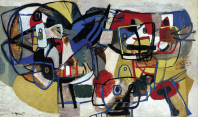Abstract
During the medieval and early modern periods, lions served as a common motif in Ashkenazic Jewish culture, bearing diverse symbolism. Also in literature written in Yiddish, the vernacular language of Ashkenazic Jews, lions were often mentioned. In this article, three songs about a man fighting a lion – Samson, David, and Benaiah – found within early modern Yiddish epics, are presented. An analysis of these songs' similar content and form suggests that they are short epic songs which have been initially orally transmitted, and later incorporated into the written long epics in Yiddish which have come down to us. In two of the songs the hero holds the lion's mouth with both hands, shortly before subduing him, an image common in Jewish art but lacking any basis in Jewish texts. This study identifies a Christian background to this image, namely that Samson's battle with the lion foreshadows the Harrowing of Hell and Jesus' releasing mankind’s souls from eternal damnation. The study points to the close cultural ties between Jews and Christians in the medieval and early modern eras, which were possible in the sphere of vernacular Yiddish literature. This closeness brought about influences which do not seem to exist in Hebrew literature.Except where otherwise noted, the content of this site is licensed under a Creative Commons Attribution-ShareAlike 4.0 International (CC BY-SA 4.0).
Authors retain copyright of their work. The CC BY-SA 4.0 licence allows readers to copy and redistribute the material in any medium or format, and to remix, transform, and build upon the material for any purpose, even commercially, as long as the original author is credited and as long as any works that are derived from the original are distributed under the same terms.
Metrics
Metrics Loading ...

